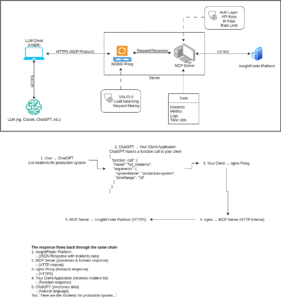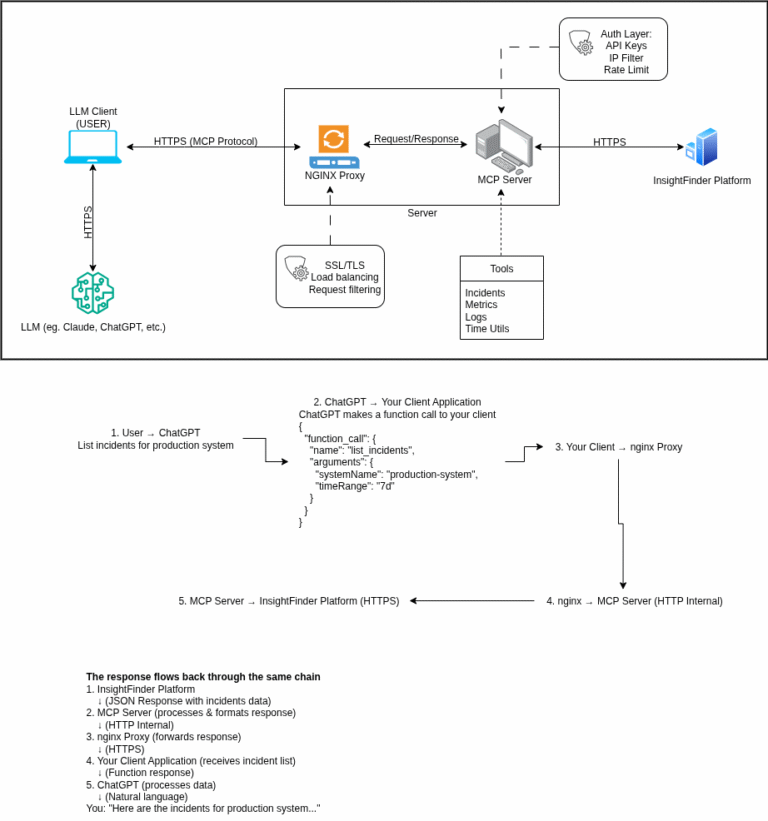Model Context Protocol, or MCP, servers have seemingly become the new API server, with many products getting one these days. But these powerful new tools can also leave you exposed if you’re not careful.
Imagine your MCP Server as the front door to your valuable data, InsightFinder or otherwise. Just like you wouldn’t leave your house door unlocked in a busy neighborhood, you shouldn’t leave your server unprotected on the internet.
This guide will help you understand why security for your MCP server is crucial and how to harden it properly, even if you’re not a security expert. This post is specific to InsightFinder’s MCP server, but the guidance should also apply to any MCP server.
What Could Go Wrong Without MCP Server Security?
Here are some real world scenarios:
Unauthorized users accessing sensitive monitoring data can lead to data theft, while attackers overwhelming your server can cause service disruption and make it unavailable. Compromised systems can result in a significant financial impact due to downtime and lost revenue. Furthermore, unprotected data can expose you to regulatory penalties, leading to compliance violations.
Approaching the security landscape means thinking about how to build the best defense for these kinds of threats. A solid defense begins with using multiple security layers. Good security works like an onion: use multiple layers of protection, like so.
- Outer layer: Network-level protection (firewalls, IP filtering)
- Middle layer: Application-level security (authentication, rate limiting)
- Inner layer: Data protection (encryption, access controls)
- Core: Monitoring and incident response
If one layer fails, others are there to protect you.
Core Security Concepts for MCP Hardening

What it is: Authentication is like showing your ID at a club—proving you’re allowed to enter.
Why it matters: Without authentication, anyone can access your server and your data.
Real-world analogy: Your ATM card (something you have) plus your PIN (something you know) proves you’re authorized to access your bank account.
In MCP Server terms:
API Keys: Like a special password that applications use
Bearer Tokens: Like a temporary access badge
Basic Authentication: Traditional username/password combination
2. Rate Limiting: Controlling the Flow
What it is: Rate limiting is like having a bouncer at a club who only lets in a certain number of people per minute.
Why it matters: Prevents attackers from overwhelming your server with too many requests.
Real-world analogy: A popular restaurant limits how many reservations they take per hour to ensure good service for everyone.
How it works:
– Your server tracks how many requests each user makes
– If someone exceeds the limit (default: 60 requests per minute), they’re temporarily blocked
– Legitimate users are rarely affected; attackers are stopped
3. IP Whitelisting: Controlling Who Can Connect
What it is: Like having a guest list at an exclusive party—only people from approved locations can connect.
Why it matters: Even if someone has your authentication credentials, they can’t connect from unauthorized locations.
When to use:
– Internal corporate networks: Only allow connections from office IPs
– Partner integrations: Only allow specific business partners to connect
– Home office setups: Only allow connections from your home network
4. HTTPS and Encryption: Protecting Data in Transit
What it is: HTTPS is like sending mail in a locked briefcase instead of a transparent envelope.
Why it’s critical: Without HTTPS, everything is sent in plain text that anyone can read.
What gets encrypted:
– Your API keys and passwords
– All data requests and responses
– User credentials and session information
Real-world impact: Without HTTPS, someone on the same Wi-Fi network could steal your credentials just by listening to network traffic.
5. Reverse Proxy (nginx): Your Security Gateway
What nginx is: Think of nginx as a highly trained security guard stationed in front of your building.
Why use nginx instead of direct connections:
The Bouncer Analogy
Imagine your MCP server is a shy, brilliant scientist working in a lab. They’re great at their job but not good at dealing with crowds or troublemakers. nginx is like hiring a professional bouncer to stand at the door:
What the bouncer (nginx) does:
– Checks IDs: Verifies visitors before they can enter
– Handles crowds: Manages busy periods without overwhelming the scientist
– Blocks troublemakers: Stops obvious attackers at the door
– Provides directions: Routes visitors to the right place efficiently
– Keeps records: Logs who visits and when
Technical benefits:
– SSL termination: Handles all encryption/decryption work
– Load balancing: Distributes traffic across multiple servers if needed
– Request filtering: Blocks malicious requests before they reach your application
– Static file serving: Handles documentation and assets efficiently
– Compression: Makes responses smaller and faster
Why Not Connect Directly?
Without nginx (direct connection):
Internet → Your MCP Server (vulnerable, overwhelmed)
With nginx (recommended):
Internet → nginx (filters, secures) → Your MCP Server (protected)
Direct connections expose your application server to: – SSL/TLS complexity and vulnerabilities – Direct attacks on your application code – Performance issues under high load – Difficulty implementing security policies
6. CORS: Controlling Browser Access
What CORS is: Cross-Origin Resource Sharing controls which websites can access your server from a web browser.
The security problem: By default, any website could make requests to your server from a user’s browser, potentially stealing data or performing unauthorized actions.
How CORS helps: You explicitly list which websites are allowed to access your server.
Example configuration:
HTTP_CORS_ENABLED=true HTTP_CORS_ORIGINS=https://your-dashboard.com,https://your-monitoring-app.com
Step-by-Step Implementation for MCP Hardening
Phase 1 – Basic Security (Essential)
Step 1: Enable Authentication – Choose your method based on your needs:
Option A: API Key (Recommended for most users)
# In your .env file HTTP_AUTH_ENABLED=true HTTP_AUTH_METHOD=api_key HTTP_API_KEY=your-very-secure-api-key-here
How to create a secure API key:
# Generate a random 32-character key openssl rand -base64 32
Option B: Bearer Token (For OAuth integrations)
HTTP_AUTH_ENABLED=true HTTP_AUTH_METHOD=bearer HTTP_BEARER_TOKEN=your-bearer-token-here
Option C: Basic Authentication (Simple but less secure)
HTTP_AUTH_ENABLED=true HTTP_AUTH_METHOD=basic HTTP_BASIC_USERNAME=admin HTTP_BASIC_PASSWORD=your-strong-password-here
Step 2: Configure Rate Limiting
# Prevent abuse by limiting requests HTTP_RATE_LIMIT_ENABLED=true MAX_REQUESTS_PER_MINUTE=60 # Adjust based on your needs
Choosing the right limit:
– Conservative (30-60): Good for small teams or light usage
– Moderate (100-200): Suitable for medium-sized operations
– High (300+): For high-traffic scenarios or automated systems
Step 3: Set Request Size Limits
# Prevent large payload attacks MAX_PAYLOAD_SIZE=1048576 # 1MB - adjust as needed
Phase 2: Network Security (Important)
Step 4: Configure IP Whitelisting (If Applicable)
When to use: – Internal corporate deployments – Limited partner access – High-security environments
# Single IP address HTTP_IP_WHITELIST=192.168.1.100 # Multiple IPs and networks HTTP_IP_WHITELIST=192.168.1.0/24,10.0.0.100,203.0.113.15
Understanding CIDR notation:
– 192.168.1.100 = Only this specific IP
– 192.168.1.0/24 = All IPs from 192.168.1.1 to 192.168.1.254
– 10.0.0.0/8 = Large corporate network range
Step 5: Setup HTTPS with nginx
Why HTTPS is mandatory:
– Encrypts all communication
– Prevents credential theft
– Required for compliance
– Builds user trust
Quick setup using provided scripts:
For production with a real domain:
sudo ./scripts/setup-https.sh your-domain.com 8000
For local testing:
sudo ./scripts/setup-local-https.sh
Phase 3: Advanced Security (Recommended)
Step 6: Configure Secure nginx Settings
The provided nginx configuration includes many security best practices:
SSL/TLS Security:
# Only use modern, secure protocols ssl_protocols TLSv1.2 TLSv1.3; # Use strong cipher suites ssl_ciphers ECDHE-RSA-AES256-GCM-SHA512:DHE-RSA-AES256-GCM-SHA384;
Security Headers:
# Prevents clickjacking attacks add_header X-Frame-Options DENY; # Prevents MIME type sniffing add_header X-Content-Type-Options nosniff; # Enables XSS protection add_header X-XSS-Protection "1; mode=block"; # Forces HTTPS for future visits add_header Strict-Transport-Security "max-age=31536000; includeSubDomains" always;
Step 7: Environment-Specific Configuration
Development environment:
TRANSPORT_TYPE=http SERVER_HOST=127.0.0.1 # Only local access HTTP_AUTH_ENABLED=true HTTP_RATE_LIMIT_ENABLED=true MAX_REQUESTS_PER_MINUTE=100 # More lenient for testing ENABLE_DEBUG_MESSAGES=true # Helpful for troubleshooting
Production environment:
TRANSPORT_TYPE=http SERVER_HOST=127.0.0.1 # Behind nginx BEHIND_PROXY=true TRUST_PROXY_HEADERS=true HTTP_AUTH_ENABLED=true HTTP_RATE_LIMIT_ENABLED=true MAX_REQUESTS_PER_MINUTE=60 # Conservative limit ENABLE_DEBUG_MESSAGES=false # Disable verbose logging
Step 8: Configure CORS Properly
Secure CORS configuration:
HTTP_CORS_ENABLED=true # Never use * in production - specify exact domains HTTP_CORS_ORIGINS=https://your-dashboard.com,https://your-app.com
Avoid wildcards (*) because they:
– Allow any website to access your API
– Create potential security vulnerabilities
– Defeat the purpose of CORS protection
Monitoring and Maintenance
Security Events to Track:
1. Authentication failures – Potential brute force attacks
2. Rate limit violations – Possible abuse or misconfigured clients
3. IP whitelist blocks – Unauthorized access attempts
4. Unusual traffic patterns – Potential attacks or system issues
Log Analysis:
# Check nginx access logs for suspicious activity sudo tail -f /var/log/nginx/mcp-server-access.log # Look for authentication errors in application logs grep "AuthenticationError" /path/to/your/logs # Monitor rate limiting events grep "Rate limit exceeded" /path/to/your/logs
Security has a performance impact and you should understand the trade-offs:
| Security Feature | Performance Impact | Recommendation |
|---|---|---|
| Authentication | Very Low (~1-2ms) | Always enable |
| Rate Limiting | Low (~0.5ms) | Always enable |
| IP Whitelisting | Very Low (~0.1ms) | Enable when applicable |
| HTTPS/SSL | Low (~5-10ms) | Always enable |
| Request Size Limits | Very Low (~0.1ms) | Always enable |
The cost of not having security is always higher than the minimal performance impact.
Best Practices for MCP Server Hardening
The Golden Rules
- Never disable authentication – Even in development, use test credentials
- Always use HTTPS – Never send credentials over HTTP
- Keep software updated – Regularly update nginx, Python, and dependencies
- Monitor continuously – Set up alerts for security events
- Test your security – Regularly verify your configuration works correctly
- Document everything – Keep records of your security configuration
- Plan for incidents – Have response procedures ready
Conclusion
Security isn’t a one-time setup—it’s an ongoing process of protection, monitoring, and improvement. By following this guide, you’ve implemented multiple layers of security that will protect your MCP Server from common attacks and provide early warning of potential issues.
Remember: The goal isn’t perfect security (which doesn’t exist), but reasonable protection that makes attacking your server more difficult and expensive than the potential gain for attackers.
Your MCP Server is now protected by:
– Authentication – Only authorized users can access
– Rate limiting – Prevents abuse and overload
– Network controls – Filters traffic at the network level
– Encryption – Protects data in transit
– nginx security – Professional-grade web server protection
– Monitoring – Early warning system for issues
You can use these tips for hardening any MCP server. You can also check out InsightFinder’s MCP server to learn how you can get comprehensive incident management, anomaly detection, and system monitoring capabilities within your AI agents. To test out InsightFinder’s MCP Server, sign up for a free trial.


